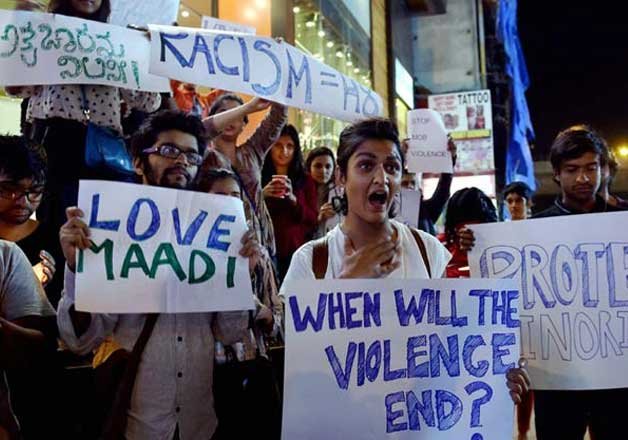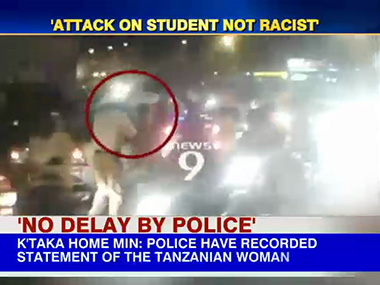…provided they find someone darker.

By Sandipan Sharma, Firstpost.com Author
Indians love to see the world in black and white. For most of us, everybody with fair skin is a gora angrez, someone with dark skin is either a ‘Madrassi’ or a kaala and the rest are all chinkis. In three simple worlds, we neatly arrange most of the world’s six billion.
Is it a big surprise then that a mob in Bengaluru meted out instant justice — after an African driver hit somebody’s car — by attacking the next kaala they saw? No, it isn’t. In Gandhi’s India, the mob motto is simple: A black eye for a black eye, a kaala for a kaala, a Tanzanian for a Sudanese. To us Indians, they are all the same.
So, a few minutes after the accident and not satisfied with burning down the car of the accused driver, an angry crowd pounced on the next group of Africans that drove past. They reportedly beat up one of the women, tore up her clothes and then paraded her on the road. It didn’t matter to them the woman was in no way connected to the driver. Or that she was a Tanzanian, which is a separate country, some 2,100 kilometres from Sudan — the motherland of the aforementioned driver.
Imagine an Indian woman being thrashed on the streets of New York just because an Iranian driver rammed his car into someone! It can happen in India, though.
Racism and colour bias, just like casteism and corruption, are ingrained so deep in our psyche that it is difficult to understand why we should be in denial in the first place. They are such well-established tenets of the Indian way of life that we might as well do the Full Monty and proudly proclaim,garv se kaho ham racist hain.
We mainstreamed, morally-validated our colour bias long ago. We want our bahus to be homely, comely, fair and lovely. Though a few shades of grey can be overlooked for a little extra dowry. To marry them, the boys are expected to become fair and handsome by rubbing creams onto their unfortunate faces.
In cinema, especially in the South, the heroine has to be a billion shades brighter than the hero. Such is the obsession with fair skin that even discards from Bollywood are preferred over actors from the southern states. And the hero’s machismo is considered directly proportional to the difference between his own and the shade of the skin of the woman he conquers. (Aptly captured by a Rajinikanth dialogue in a Hindi film, perhaps Uttar Dakshin — or was it Asli Naqli? — when he boasts, kaale gaal pe gori pappi, after the heroine obliges him with a peck.)
CLICK TO ALSO READ UPDATE: When racism plays out in subtle ways in everyday life, it doesn’t provoke debate. It is only when it takes a violent turn, as it did in Bengaluru, that we are forced to address it
Politicians practice racism both inadvertently and shamelessly. A few weeks ago, BJP leader Giriraj Singh Kishore had wondered if Rajiv Gandhi had married a Nigerian woman, would his wife have been accepted as a leader by the Congress. Not knowing, that the slur was not on Sonia or Rajiv, but on Indians who colour their choices with racism. (But let’s grant it to him, at least he did proclaim our racism.)
Before that, then Goa Chief Minister Manohar Parrikar had informed the Assembly that an “unknown African Negro” had been arrested in connection with a crime. When reminded of his racist slur, Parrikar clarified that Negro also means a river in the Amazon and apologised to those who were hurt by the other meaning. Before that, his minister for art and culture, Dayanand Mandrekar, dubbed Nigerians as a “cancer”, after a group of African nationals were involved in blocking a road in Goa.
And then there was AAP’s Somnath Bharti, leading a mob on a dark night, like Amitabh Bachchan inShahenshah against Africans whom he (Bharti not Bachchan) accused of polluting the culture and environment of an entire locality in Delhi.
Ironically, racism, again like casteism, is rampant in India despite the fact that each one of us is a potential victim. Within India, anybody who is higher up on the colour chain can target those below. So, North Indians call South Indians kaala, who, in turn, discard from pop culture women who are of the same shade. Everyone is a potential racist, provided they get someone darker than themselves.
And when all these Indians — from Punjabis and Sindhis to Gujaratis and Marathas, to South Indians and Northeast Indians, and all the way to Bengalis and Odiyas — step out of the subcontinent, they themselves become potential targets for other racists. At every level, racism begets racism. Yet, there is no empathy for others among Indians.
Often, our racist behaviour turns our history and diplomacy into a farce. When he fought apartheid in South Africa, Nelson Mandela gave a lot of credit to Mahatma Gandhi’s ideals for his eventual success. Little must Mandela have known that the apartheid he fought would be practiced against his own people in the very country of his alleged inspiration.
Historically, we were considered closer to the Africans because of the shared colonial history and pain, our Non-Aligned Movement and Gandhi’s history of struggle in Africa. Yet, we would rather serve in a gora household than dine at the same table with Africans. We’d rather die genuflecting at the feet of an angrez, treating him like god, yearning for his appreciation, getting offended by his typecasting of us in a pop video — the brouhaha over Coldplay — and the denial of visas to our leaders by the West, and yet not treat Africans as equals or with respect.
We’re a country that thrives on Fair and Lovely. Yet, our world of black and white remains unfair and ugly. Source: Firstpost.




